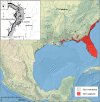Ritual Black Drink consumption at Cahokia
- PMID: 22869743
- PMCID: PMC3435207
- DOI: 10.1073/pnas.1208404109
Ritual Black Drink consumption at Cahokia
Abstract
Chemical analyses of organic residues in fragments of pottery from the large site of Cahokia and surrounding smaller sites in Illinois reveal theobromine, caffeine, and ursolic acid, biomarkers for species of Ilex (holly) used to prepare the ritually important Black Drink. As recorded during the historic period, men consumed Black Drink in portions of the American Southeast for ritual purification. This first demonstrated discovery of biomarkers for Ilex occurs in beaker vessels dating between A.D. 1050 and 1250 from Cahokia, located far north of the known range of the holly species used to prepare Black Drink during historic times. The association of Ilex and beaker vessels indicates a sustained ritual consumption of a caffeine-laced drink made from the leaves of plants grown in the southern United States.
Conflict of interest statement
The authors declare no conflict of interest.
Figures


References
-
- Emerson TE. Cahokia and the Archaeology of Power. Tuscaloosa: Univ of Alabama Press; 1997.
-
- Milner GR. The Cahokia Chiefdom: The Archaeology of a Mississippian Society. Washington, DC: Smithsonian Institution Press; 1998.
-
- Pauketat TR. The Ascent of Chiefs: Cahokia and Mississippian Politics in Native North America. Tuscaloosa: Univ of Alabama Press; 1994.
-
- Pauketat TR. Ancient Cahokia and the Mississippians. Cambridge: Cambridge Univ Press; 2004.
-
- Pauketat TR, Lopinot NH. Cahokian Population Dynamics. In: Pauketat TR, Emerson TE, editors. Cahokia: Domination and Ideology in the Mississippian World. Lincoln: Univ of Nebraska Press; 1997. pp. 103–123.
Publication types
MeSH terms
Substances
LinkOut - more resources
Full Text Sources
Research Materials

